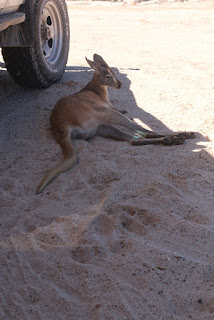 |
| Stockyard Gully Tunnel |
Our vehicle was eventually released to us after being held by customs for 10 days for a random check, and then after a 5 minute examination by the quarantine officer we were declared clear. The final pieces of the jigsaw were to get the car serviced and then tested by the Dept of Transport, who also OK'd it so we were then free to drive. Having provisioned ourselves we immediately set off north from Perth and have spent the last 10 days visiting many of their fabulous National Parks en route. We spent the first night in the van in nearly six weeks in Yanchep NP, 70kms N of Perth where we were entertained by a pair of male kangaroos fighting. From there we have visited Pinnacles NP, where remarkable limestone pillars have been left in a sandy desert, Leseur NP to see the Spring flowers, Stockyard Gully where we walked through a 250m long natural limestone tunnel, once used by herders to hold their cattle.
 |
| Natures Window Kalbarri NP |
Following the Indian Coast Road has meant we have been able to cut off to the coast to camp and enjoy the long sandy coastline. As we progressed north sections of the coast have become rocky with some spectacular headlands and cliffs. We drove to the most westerly point of Mainland Australia at Steep Point crossing a couple of sand dunes en route, but were alos rewarded with visiting some fantastic blowholes in the cliffs where we could hear the air being forced up from 100 ft below. When there is a real swell in the sea at high tide they discharge fountains of water, despite being 100ft above sea level.
 |
| Heading N back into the Tropics |
We have become very conscious of just how big Australia is, the roads are excellent with relatively little traffic, a real contrast to Indonesia, but the distances are huge. Communities are separated by 100's of kms so it is essential to keep a close eye on fuel levels, it may be 150kms to the next fuel station, even on a main road. The landscape also changes slowly with large areas of scrubland, and as we have travelled further north increasingly arid landscapes with sparse grass and small trees / shrubs. It is amazing that these areas are used for grazing with cattle and sheep straying over 10's of kms
 |
| Western Tip of Australia |
One highlight was an evening whale watching trip from Exmouth where we were privileged to see around a dozen humpback whales, many with calves, displaying most of their antics, breaching, fin and tail slapping and beautiful tail fin dives. I was fantastic to be near to these huge and docile creatures. From a population of fewer than 1000 migrating along this coast in the early 1960's there are now around 30,000, with the population still growing.
 |
| Breaching humpback whale |
The following day we were sitting in a beach car park about to have lunch when a group of 3 kangaroos decided to rest in the shade of our van, it was the only shade around, so we ate lunch while these inquisitive visitors watched or snoozed around 3 ft away. We have now travelled sround 200kms inland and spent the day in Karijini NP - a huge area of undulating scrubland cut by numerous deep and often narrow gorges. Trails wind down into the gorges where there are several tranquil pools ideal for swimming.
A fantastic country with lots to see and do, but also huge distances to cover.
 |
| Blowholes |
 |
| Chilled Kangaroo |
 |
| Canyons in Karijini NP |
 |
| Walking a narrow canyon |









No comments:
Post a Comment